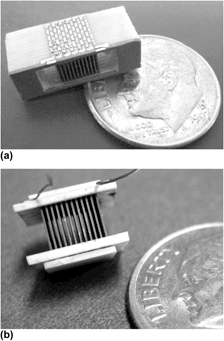Crossref Citations
This article has been cited by the following publications. This list is generated based on data provided by
Crossref.
Roth, R.
Rostek, R.
Lenk, G.
Kratschmer, M.
Cobry, K.
and
Woias, P.
2013.
Two-layer process for a micro thermoelectric cross-plane generator with electroplating and reflow soldering.
p.
486.
Muñoz-Rojo, Miguel
Caballero-Calero, Olga
and
Martín-González, Marisol
2013.
Electrical contact resistances of thermoelectric thin films measured by Kelvin probe microscopy.
Applied Physics Letters,
Vol. 103,
Issue. 18,
Shaughnessy, M. C.
Bartelt, N. C.
Zimmerman, J. A.
and
Sugar, J. D.
2014.
Energetics and diffusion of gold in bismuth telluride-based thermoelectric compounds.
Journal of Applied Physics,
Vol. 115,
Issue. 6,
p.
063705.
García-Cañadas, Jorge
and
Min, Gao
2014.
Low Frequency Impedance Spectroscopy Analysis of Thermoelectric Modules.
Journal of Electronic Materials,
Vol. 43,
Issue. 6,
p.
2411.
Roth, Reinhard
Rostek, Raimar
Cobry, Keith
Kohler, Christian
Groh, Moritz
and
Woias, Peter
2014.
Design and Characterization of Micro Thermoelectric Cross-Plane Generators With Electroplated ${\rm Bi}_{2}{\rm Te}_{3}$ , ${\rm Sb}_{x}{\rm Te}_{y}$ , and Reflow Soldering.
Journal of Microelectromechanical Systems,
Vol. 23,
Issue. 4,
p.
961.
García-Cañadas, Jorge
and
Min, Gao
2014.
Impedance spectroscopy models for the complete characterization of thermoelectric materials.
Journal of Applied Physics,
Vol. 116,
Issue. 17,
Williams, H.R.
Ambrosi, R.M.
Chen, K.
Friedman, U.
Ning, H.
Reece, M.J.
Robbins, M.C.
Simpson, K.
and
Stephenson, K.
2015.
Spark plasma sintered bismuth telluride-based thermoelectric materials incorporating dispersed boron carbide.
Journal of Alloys and Compounds,
Vol. 626,
Issue. ,
p.
368.
Ren, Fei
Menchhofer, Paul
Kiggans, James
and
Wang, Hsin
2016.
Development of Thermoelectric Fibers for Miniature Thermoelectric Devices.
Journal of Electronic Materials,
Vol. 45,
Issue. 3,
p.
1412.
Ngan, Pham Hoang
Han, Li
and
Christensen, Dennis Valbjørn
2018.
Joining of Half-Heusler and Bismuth Tellurides for Segmented Thermoelectric Generators.
Journal of Electronic Materials,
Vol. 47,
Issue. 1,
p.
701.
Yu, Yuedong
Guo, Zhanpeng
Zhu, Wei
Zhou, Jie
Guo, Siming
Wang, Yaling
and
Deng, Yuan
2022.
High-integration and high-performance micro thermoelectric generator by femtosecond laser direct writing for self-powered IoT devices.
Nano Energy,
Vol. 93,
Issue. ,
p.
106818.
Cao, Tianyi
Shi, Xiao-Lei
Li, Meng
Hu, Boxuan
Chen, Wenyi
Liu, Wei-Di
Lyu, Wanyu
MacLeod, Jennifer
and
Chen, Zhi-Gang
2023.
Advances in bismuth-telluride-based thermoelectric devices: Progress and challenges.
eScience,
Vol. 3,
Issue. 3,
p.
100122.
Rao, Yongchen
Voss, Matthias
Bechtold, Tamara
and
Hohlfeld, Dennis
2023.
Implantable Thermoelectric Generator with High Aspect Ratio Thermolegs and Integrated Voltage Converter.
p.
206.
Rao, Yongchen
Xu, Chu
Voss, Matthias
Ying, Pingjun
Reith, Heiko
Nielsch, Kornelius
Bechtold, Tamara
and
Hohlfeld, Dennis
2024.
Fabrication and Characterization of a Thermoelectric Generator with High Aspect Ratio Thermolegs for Electrically Active Implants.
Advanced Materials Technologies,
Vol. 9,
Issue. 1,
Amiri, L.
Liang, C.-T.
Narjis, A.
and
Alsaad, A.
2024.
Geometry optimization of a thermoelectric generator with temperature-dependent properties.
Applied Physics A,
Vol. 130,
Issue. 6,
Naumov, Andrii
Chrobak, Maciej
Trembułowicz, Artur
Jurczyszyn, Michał
Maćkosz, Krzysztof
Stępień, Joanna
Sikora, Marcin
and
Przybylski, Marek
2024.
The in-plane band bending effect around Au islands grown on the Bi2Te3 topological insulator.
Surface Science,
Vol. 745,
Issue. ,
p.
122490.
